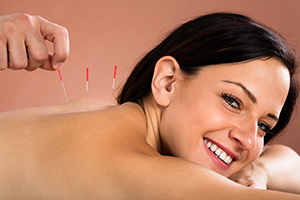Acupuncture Therapy for Cirrhosis in North Hollywood, CA

For decades, researchers have observed the therapeutic effects of ancient Chinese acupuncture needling on liver function. How Traditional Chinese Medicine (TCM) practitioners achieved those effects used to be a mystery – it couldn’t be explained using Western clinical terminology.
Until now.
In 2018 a powerful, cutting edge microscope enabled researchers to finally see and photograph the interstitium, a highly organized, fluid-filled space between our skin and our muscles1. This discovery provided a clinical explanation for what ancient TCM practitioners called “moving the Qi” with acupuncture needles.
Like a river, the interstitium can flood your body with enzymes and biochemicals. An acupuncturist diverts the flow of harmful ones and stimulates helpful ones (while potentially tapping regenerative stem cells) to accomplish optimal biochemical balance. Restoring balance may halt the progression of cirrhosis .
Cirrhosis is severe scarring (fibrosis) of the liver that’s most often caused by chronic alcohol abuse or by hepatitis B and C . Specifically, cirrhosis results from the accumulation of extracellular matrix (ECM) proteins and the activation of fibrosis-generating hepatic stellate cells (HSC).
Acupuncture for liver cirrhosis can disrupt the actions of these proteins, increase blood and energy flow (Qi), and enhance your immunity, relieving symptoms like pain and edema . Acupuncture can also increase the effectiveness of numerous plant-based cirrhosis treatments.
To learn more about how acupuncture in North Hollywood can treat your liver damage, speak with a certified TCM practitioner or acupuncturist by calling (424) 365-1800 or contact Dr. Jeremy Fischer online today.
How does acupuncture work?
With single-use, sterile, fine needles acupuncture therapy stimulates our meridians – very low electrical resistance points on the body – which have been assigned Chinese names, English names, and numbers.
Meridians are the branching point of nerves called C-fibers along the interstitium, that fluid-filled space between our skin and our muscles.
These C-fibers carry low-grade sensory information over long distances within the body. Researchers have found that the insertion of acupuncture needles disrupts the C-fiber circuit, blocking neurotransmitter pain signals to the brain.
This needle stimulation can also activate cytokines, hormones, and inflammatory factors to help correct various biochemical imbalances and dysfunctions.
Each of our 350 meridians has a specific function and carries high concentrations of:
- immune-regulating mast cells
- lymph-transporting vessels called lymphatics
- capillaries
These pathways may transport newly activated enzymes, hormones, and proteins to damaged cells, helping to correct a variety of imbalances. Once an imbalance is corrected, the damage done to cells may be arrested, or even reversed.
TCM diagnostics for cirrhosis
TCM practitioners identify and target patterns – overlapping conditions you likely don’t realize are related. Your acupuncturist may help you avoid spending time and money seeking uncoordinated—and potentially conflicting—treatments for what you thought were individual symptoms.
After analyzing your health history, lifestyle habits, diet, and current symptoms, your TCM practitioner may perform one or more of the following:
pulse diagnosis: checking 9 pulse positions to assess both pulse speed and quality (floating, sinking, slippery, tight, wiry, excessive, deficient, abrupt, intermittent, knotted), while detecting warm or cold tendencies that indicate specific biochemical imbalances
facial diagnosis: your facial colors (white, dull white, bright white, yellow, orange/yellow, red, blue/green, black) and qualities (moist and clear or dry and lifeless) can alert a practitioner to seek further indications of a particular imbalance
tongue analysis: tongue regions correspond to various organs; tongue color (pink, pale, red, scarlet, purple, or blue) indicates cold and heat (which represents blood stagnation and mineral deficiencies), while tongue coat (normal, thick, dry, moist, wet, sticky) may indicate digestive stagnation and food retention; after diagnosis, your tongue can also gauge treatment progress
Your practitioner will meticulously analyze all this information to detect “pattern(s)” of dysfunction – your diagnosis. A web of inter-woven actions can’t always be distilled into one particular cause, especially once aging begins to takes its toll. The needles injected at your meridians will gently and gradually begin to stimulate biochemical balance.
Diagnosing these nuances, and deciding exactly where and how long to needle a patient takes time and experience. A good acupuncturist offers both.
How does acupuncture treat cirrhosis?
As with any medical procedure, results vary from patient to patient depending on age, genetics, general health, condition severity, follow-up care, and environmental factors. Acupuncture may have contraindications with other medical conditions and/or treatments. Always consult your healthcare provider before embarking on your treatment journey.
Acupuncture therapy reverses blood and energy stagnation to enhance the body’s immunity and potentially prevents the progression of cirrhosis damage2.
Liver damage is usually triggered by inflammation. Inflammation induces oxidative stress, which drives liver cell death. By reducing inflammation, acupuncture can help preserve some of the liver’s natural detoxifying abilities.
Electro-acupuncture of point ST36 has been shown to quell inflammation by:
- inhibiting the release of beta-hexosaminidase enzyme
- activating the secretion of interleukin 6 (IL-6)
- reducing nuclear factor–κB DNA-binding activity3
Your acupuncturist may target chemical imbalances in your liver by stimulating a combination of the following meridians:
- Fuliu (K7): a point on the lower leg that strengthens the kidneys
- Zhubin (K9): a point on the lower leg that reduces pain
- Shuifen (Ren9): a point on the upper-abdomen that resolves edema
- Shenshu (UB23): a point on the back that resolves edema
- Zusanli (ST36): a point on the lower leg that strengthens the body, relieves pain, promotes general wellness, and treats edema
- Taichong (LR3): a point on the foot that blocks pain receptors and prevents blood stagnation in the liver
- Qimen (LR14): this point on the lower chest sends direct biochemical messages to the liver to block pain receptors and prevents blood stagnation
- Ganshu (BL18): a point on the back that addresses jaundice , as well as regulates and nourishes liver blood
- Sanyinjiao (SP6): this point on the lower leg helps harmonize liver biochemistry
Numerous studies have analyzed how acupuncture can also increase effectiveness of the following plant-based cirrhosis treatments:2
- injecting ganlixin and danshen at ST36: significantly decreases hyaluronic acid (an indication of cirrhosis), laminin (an ECM protein), and collagen IV levels
- injecting oxymatrine at BL18, SP6, and ST36: three months of this treatment improved hyaluronic acid, laminin, procollagen III, and collagen IV serum levels in patients
- injecting tanshinone at BL18, SP6, LR14, and ST36: this main component of danshen can improve blood circulation and treat fibrosis
- injecting Matrine into ST36: this plant component can reduce the amount and collagen-synthesis of HSCs; three months of these injections improved the symptoms and liver function of cirrhosis patients
Curcumin, the active ingredient in the spice turmeric – can prevent hepatic stellate cells from activating and generating fibrosis. It can also decrease collagen production. Researchers found that acupuncture significantly enhances the effects of curcumin on in vivo rats with hepatic fibrosis. This same treatment of cirrhosis could soon be clinically verified for humans1.
The study also found that acupuncture prevents hepatic stellate cell activation, and suppresses the collection of molecules that stimulates liver damage (extracellular matrix)1.
Acupuncture is also a useful alternative for painkillers like nonsteroidal anti-inflammatory drugs, which are metabolized in the liver and are not recommended for cirrhosis patients.
Do acupuncture needles hurt?
Because they are filiform (not hollow like hypodermic needles) acupuncture needles don’t cut your tissue – they gently part it. Patients often report feeling “pressure” or “a heavy sensation”. Inserting a needle into the correct point may also cause your body to produce B-endorphin (a natural opiate 10-100 times more potent than morphine), which can circulate for several hours.
FDA regulated acupuncture needles are:
- sterile
- highly flexible
- single use
- filiform (solid)
- superfine (0.16-0.46 mm in diameter and 13-130 mm in length)
- stainless steel based (sometimes adorned with copper or gold handles)
Insertion can occasionally cause miniscule amounts of bleeding or bruising. Improper placement of the needle can also cause pain, and the needles may break, enter too deeply, or injure your organs. If you feel any pain, tell your practitioner so he or she can manipulate the angle of the needle. Some find it helpful to insert needles through a plastic guide tube.
Can acupuncture cause any side effects?
There are very few side effects of acupuncture therapy. If incorrectly placed into the skin by an untrained practitioner, these needles can enter your skin too deeply and harm your organs.
Some patients report an intense emotional release (crying or laughing) during acupuncture therapy. Minor acupuncture side effects may include:
- bleeding, swelling, soreness, or bruising at or near the meridians
- mild discomfort
- fatigue
- muscle twitching
Only receive acupuncture from a licensed, certified specialist.
Who shouldn’t receive acupuncture for cirrhosis?
Patients who may not respond well to needling include those who are pregnant or breastfeeding, as well as those who have:
- recently had surgery
- autoimmune conditions
- seizures
- bleeding disorders
- low blood pressure
- diabetes
- GERD
- breast, uterine, or ovarian cancer
- gallbladder issues
Tell your healthcare provider if you take blood thinners, anticoagulant medications, or digoxin (Lanoxin).
Reserve your appointment
When your liver is severely damaged, so is the rest of you. A holistic treatment to correct your full biochemical imbalance may be just what you need. Make an appointment with a certified acupuncturist in North Hollywood today to learn more about acupuncture for liver disease. Call (424) 365-1800 or contact Dr. Jeremy Fischer online.
Sources
1. Zhang, Feng, et al. “Acupuncture combined with curcumin attenuates carbon tetrachloride-induced hepatic fibrosis in rats.” BMJ Journals 30.2 (2012): 132-138. Web. 04 Oct. 2018.
2. Zhou, Jue et al. “Acupuncture in Treating Hepatic Fibrosis: A Review With Recommendation for Future Studies.” African Journal of Traditional, Complementary, and Alternative Medicines 9.4 (2012): 452–458. Print. 04 Oct. 2018.
3. Marí M, Colell A, Morales A, von Montfort C, Garcia-Ruiz C, Fernández-Checa JC. Redox control of liver function in health and disease. Antioxid Redox Signal. 2010;12(11):1295-1331.
Vitality Integrative Medicine
Address
4849 Van Nuys BlvdSuite 104
Sherman Oaks, CA 91403
(424) 365-1800
www.vitalityintegrative.com
Hours
Mon:
8:00 am - 6:00 pm
Tue:
8:00 am - 6:00 pm
Wed:
8:00 am - 6:00 pm
Thu:
8:00 am - 6:00 pm
Fri:
8:00 am - 6:00 pm
Sat:
8:00 am - 12:00 pm

